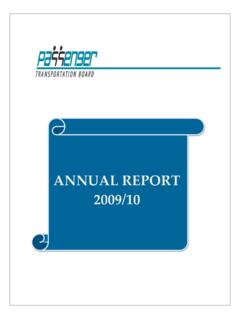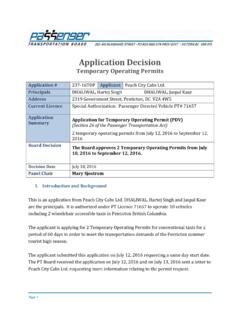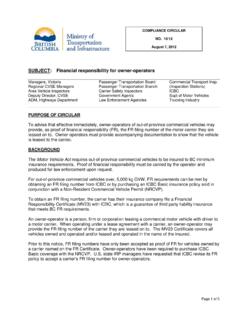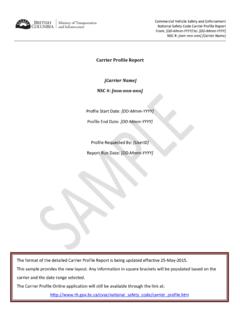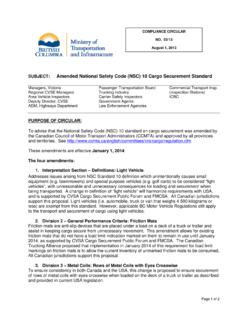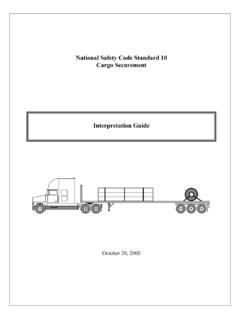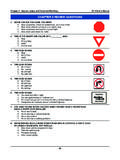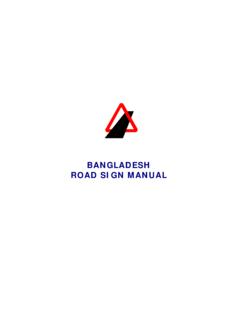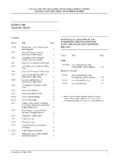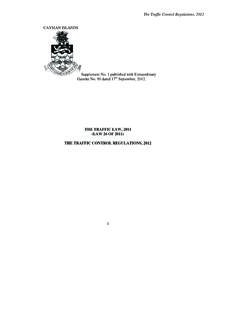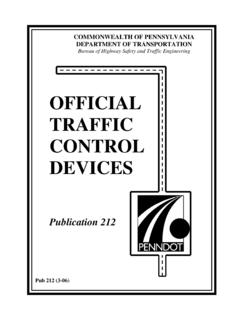Transcription of Manual of Standard Traffic Signs & Pavement …
1 Manual ofStandard Traffic Signs & Pavement MarkingsSeptember 2000 Your Comments on this ManualAny comments on this Manual or its contentsmay be directed to: Traffic & Electrical SectionMinistry of Transportation and Highways Engineering Branch4B - 940 Blanshard StreetVictoria, V8W 3E6 This edition replaces the 1998 Interim EditionCanadian Cataloguing in Publication DataBritish Columbia. Ministry of Transportation and of Standard Traffic Signs & Pavement markingsPreviously published: 0-7726-4362-81. Traffic Signs and signals - Standards - British Road markings - Standards - British Columbia.
2 I '122'0218711C00-960304-2 Continuing Record of Revisions Made to theManual of Standard Traffic SignsThis sheet should be retained permanently in this page sequence within revised material should be inspected as soon as received and the relevantentries made in the spaces provided byDate of Entry123456789101112 HOW TO USE THIS MANUALThe Decimal Indexing SystemThis Manual consists of two parts and numerous chapters andappendices. Each chapter is divided into sections and, wherenecessary, subsections. Sections and subsections are identified by adecimal numbering system; for example, the notation refers toChapter 1, Section 6, Subsection 2.
3 These numbers should not beconfused with the sign Numbers which are used to identify individualsigns, for example, when individual pages throughout the Manual are not numbered, thelocation of any subject within the text depends on the decimal indexingsystem, and the numerical progression through each and AdditionsIt may be necessary to add new sections and subsections or to revisesome of the existing ones. By using a decimal indexing system andexcluding page numbers, it will be possible to insert additional materialand still maintain numerical page has a publication date at the bottom corner.
4 Subsequentupdates will have the new revision date in the same :Different words are used throughout the Manual to emphasize thedegree to which a policy, warrant or criteria requires adherence following defines the intent of the commonly used word:SHALL:Describes a mandatory condition - it must be done regardless ofconsequence or : Describes an advisory condition - it is desirable to do but notnecessarily :Describes a permissive condition - it is optional to do but in no waynecessaryAbbreviationsThe following abbreviations have been used in the Letters for Functional Groups of Signs :C = Construction and Maintenance G = GuideI = Information P = Parking & StoppingR = Regulatory SP = School & PedestrianTW = Temporary WarningW = WarningNote: Construction & Maintenance Signs (C) and Temporary Warning Signs (TW) are detailed in the " Traffic Control Manual for Work on Roadways.
5 " sign Shapes:Diam. = DiamondOct. = OctagonPent. = PentagonRect. = RectangleSq. = SquareTrap. = TrapezoidTri. = TriangleSign Colours:B = BlackBl. = BrownG = OrangeR = RedW = WhiteY = YellowMetric Measurements:cm = centimetre km = kilometrekm/h = kilometre per hourm = metret = tonne kg = kilogramSuffixes:BUS = BusesCHIP= Chip TrucksFARM= Farm TrucksL= LeftLOG= Log TrucksR= RightRV= Recreational VehiclesSP= SpecialT= Tabx= Oversizexx= Oversizexxx= OversizeThe letters L and R identify left and right equivalents of the same letter T denotes a tab which is generally used only with the sign havingthe same number less :Bgd.
6 = BackgroundFl. = FullyMess. = MessageRefl. = ReflectorizedSy. = SymbolTABLE OF General Authority and Requirements of Functional groups of Standardization of Standardization of Shape and Interdictory and mandatory/permissive Retroreflectivity and Means of Means of Standardization of Side of the Longitudinal Lateral Mounting and sign Posts and Overhead sign City & Destination Selection Conventions for Guide Colour and Signs and sign Warrants and Application Guide Conventions for G-5 sign
7 TheoryFig. to Sample Guide sign and Pedestrian Pavement Longitudinal Double Single Solid Dividing Lane Edge Transverse Pavement Stop Lane Use Letters and Chevron and Crosswalks Marking in Gore Chevron Pavement Markings in Gore Crosshatch Pavement Markings in Advance Crossing Raised Pavement Markers (RPM s). Guidelines for RPM Reflective White RPM Reflective Yellow RPM Reflective Yellow RPM Reflective Red an White Reflectors CMB & Delineators on Conventional Delineators on Freeway and Reserved Left Turn Pavement Two Way Left Turn Median Lane Intersection No Passing Barrier Field MeasurementAppendix sign Placement Table I, References.
8 Definitions CHAPTER 1 GENERAL PROVISIONSS eptember ofTransportationand edition of the British Columbia Manual of Standard Traffic Signs & PavementMarkings replaces the Interim Edition dated May 1989 and is in effect October1, edition now includes the Information sign Chapter and the Pavement Manual is in general conformance with the Manual of Uniform Traffic ControlDevices for Canada. It also conforms with Motor Vehicle Act Regulations,Division 23, which specifies the designs for a number of the Signs contained withinthis of design and application aids recognition and understanding ofsigns and is important in obtaining motorist compliance and have a right to expect that any given Traffic sign will always have thesame meaning and will require the same response, regardless of where the signis encountered.
9 Similar situations where Signs are warranted should, therefore,be signed in a similar a Traffic sign is correctly used, the majority of motorists will comply with theposted regulation or warning, and drive in a safe and orderly manner. Trafficsigns are most likely to be ignored if insufficient thought and attention has beengiven to their Manual cannot provide solutions for every signing problem. Professionaljudgment will often be required to resolve a situation, but the principles outlined inthis Manual must always be followed.
10 Any operational problem addressed bysigning should be regarded as a temporary solution, until a field study proves thesolution is successful. Standardization is important and cannot be over-emphasized. Standard Signs must be used wherever practical, and special signsused only when a suitable Standard sign will not adequately address the 2 to 6 of The Manual of Standard Traffic Signs & Pavement Markingsprovides standards for design and use of Traffic Signs , but is not intended tooverride good engineering judgment; nor are the recommended standardsintended to be a legal requirement.

